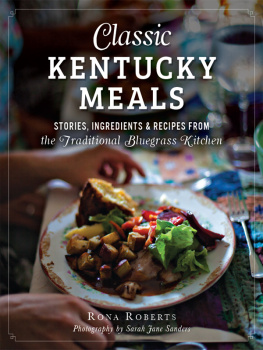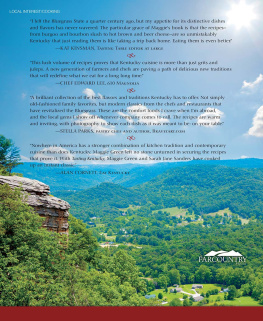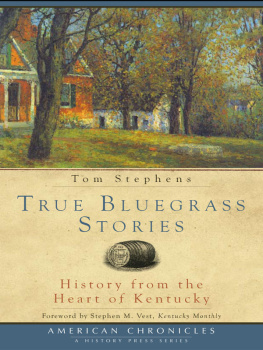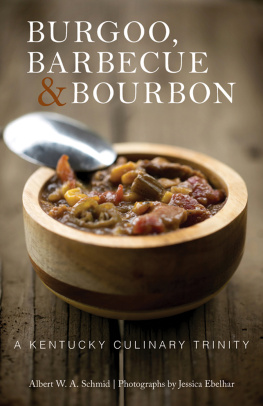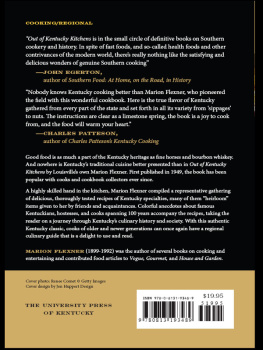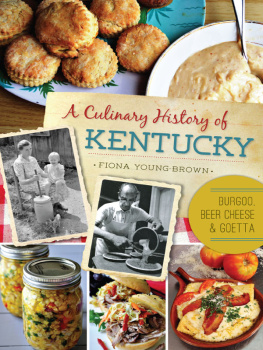

Published by American Palate
A Division of The History Press
Charleston, SC 29403
www.historypress.net
Text copyright 2014 by Rona Roberts
Photography copyright 2014 by Sarah Jane Sanders
All rights reserved
Cover image by Sarah Jane Sanders.
First published 2014
e-book edition 2014
ISBN 978.1.62585.260.1
Library of Congress Control Number: 2014951887
print edition ISBN 978.1.62619.719.0
Notice: The information in this book is true and complete to the best of our knowledge. It is offered without guarantee on the part of the author or The History Press. The author and The History Press disclaim all liability in connection with the use of this book.
All rights reserved. No part of this book may be reproduced or transmitted in any form whatsoever without prior written permission from the publisher except in the case of brief quotations embodied in critical articles and reviews.
With gratitude to those whose work fills the dishes and makes the meals on Kentuckys many tables

Rebecca Gladding serves friends and family the delicious, not-too-fancy sorghum meal: utterly Kentucky. Sarah Jane Sanders.
CONTENTS
PREFACE
On a bright February morning in 2014, I drove through gorgeous central Kentucky with a loyal friend in a car filled with rich cooking smells. I looked forward, at long last, to putting my 4-H demonstration training to good use: I had agreed to do a presentation on how to cook with sorghum to help raise money for the Arts Council of Mercer County.
I had let the mission grow from a simple Talk about sorghum and tell why you wrote a book about it into something like the final project for a graduate course I never took: Cook and serve a meal featuring sorghum nine ways, using as many ingredients from as many Kentucky producers as possible; explain your reasoning and intent.
As we stepped onto the front walk of beautiful, historic Nathaniel Burrus House, Kentuckys sweet winter beauty and fertility surrounded us. We stood above a landscape of rolling fields, and I could almost see Four Hills Farm, the source of the meals main dish: a savory lamb shoulder, braised with just a touch of sorghum.
Subtract a few utility lines, and the people who built the house in 1830 likely saw much of the same loveliness and promise all around them on a similar February morning nearly two hundred years ago. If we are good stewards, our unknown descendants will stand on that spot in 2230 and sense the same goodness and potential.
At any time across four hundred years, similar savory scents from fine local ingredients might be coming from the kitchen to meet us, drawing us in for conviviality and sustenance. What grows in Kentucky, we trust, will keep growing in Kentucky, giving Kentuckians our best source of wealth in every sense.

Joydah Bernardo slices Braised Pork Shoulder for the table. Sarah Jane Sanders.
Working on that meal brought focus to years of puzzling over several themes that show up often in Savoring Kentucky, my long-running food weblog about Kentucky food and the people who grow it:
What parts of Kentuckys way of eating are as timeless as our land?
What ways of eating are distinctively our own?
How can home cooks make Kentucky-based meals that are good in every way: for our taste buds and our health, for growers as well as eaters, for everyone in all of our communities?
How can we widen the number of families who eat what Kentucky grows?
Who gets hurt if we call it a cuisine?
If we call our way of eating a cuisine, can we still include cornbread?
In The Third Plate, legendary New York chef Dan Barber points out that cuisine (French for kitchen) means the foods peasants cooked from what they could grow, wherever they lived around the world. In an interview with Eater.com, Barber said, All of them were just negotiating, eking out what the land could provide, and then [they] figured out a way to make it nutritious and delicious.

One share from Elmwood Stock Farms spring CSA basket is bountiful. Sarah Jane Sanders.

Sour Cherry Lemonade is perfect for early summer meals. Sarah Jane Sanders.
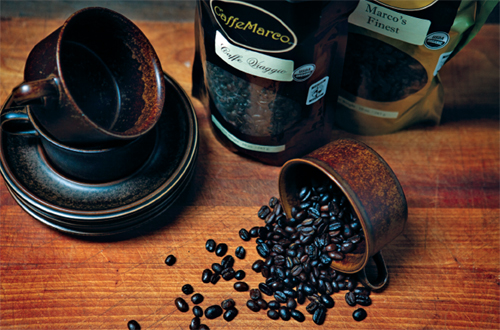
CaffeMarco in Paris is a pioneering Kentucky-based coffee roaster. Sarah Jane Sanders.

Tea from Elmwood Inn Fine Teas is treasured around the world. Sarah Jane Sanders.

Kentucky wineries like Horseshoe Bend make delicious wines from Kentucky grapes. Sarah Jane Sanders.
That sounds like turnip greens cooked with leftover pork scraps to mewith some vinegar. And please pass the crusty cornbread. Ill have a little sorghum with mine. Im eating Kentucky cuisine, so please tell me a good story and keep that Reel World String Band music playing.
Kentucky soil, water, climate and farmers can grow a nearly infinite array of wondrous foods. What would we like them to grow? We let them know the answers by what we buy and eat. We define Kentucky cuisine by what and how we cook and eat at home. By eating whats good from Kentuckys farms and orchards, meal by meal, we steer Kentuckys agriculture toward a positive, permanent capacity to feed Kentuckys people. Kentucky thought leader, entrepreneur and chef Ouita Michel recently called for Kentuckians to embrace cuisine-supported agriculture. She urges us to grow, buy, cook, preserve and enjoy the foods and ways of cooking that are characteristic of our place. Lets cook and eat what we want grown. Cuisine is too important to leave only to restaurants and professional chefs.
If we want the place around us to nurture us, we can do our part by nurturing it. It means moving other tasks off our daily agenda and putting food in a more central place. We cannot drive through for an order of Kentucky cuisineat least, not yet.
Cooking the sorghum meal in Mercer County required shopping, cooking, cleaning up and composting scraps. Most of it was memorable, enjoyable time spent cooking with others, doing handwork, smelling, tasting, listening to music and exploring the mysteries of ingredients combining into new foods.
More time like thatcooking daily meals as well as celebratory feastsmeans more time shared with loved ones over chopping boards and skillets; more ways to engage children and young people in real, enjoyable work; and more time to use our human senses and faculties to take care of ourselves.
Next page
